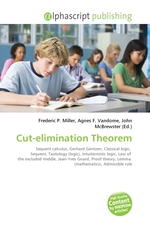Cut-elimination Theorem
Frederic P. Miller, Agnes F. Vandome, John McBrewster
бумажная книга
The cut-elimination theorem is the central result establishing the significance of the sequent calculus. It was originally proved by Gerhard Gentzen 1934 in his landmark paper "Investigations in Logical Deduction" for the systems LJ and LK formalising intuitionistic and classical logic respectively. The cut-elimination theorem (Hauptsatz) states that any judgement that possesses a proof in the sequent calculus that makes use of the cut rule also possesses a cut-free proof, that is, a proof that does not make use of the cut rule. A sequent is a logical expression relating multiple sentences, in the form "", which is to be read as "A, B, C, proves N, O, P", and (as glossed by Gentzen) should be understood as equivalent to the truth-function "If (A and B and C ) then (N or O or P)."[citation needed] Note that the left-hand side (LHS) is a conjunction (and) and the RHS is a disjunction (or). The LHS may have arbitrarily many or few formulae; when the LHS is empty, the RHS is a tautology.
Данное издание не является оригинальным. Книга печатается по технологии принт-он-деманд после получения заказа.


